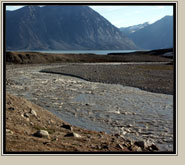 |
WILDLIFE:
Climate & Nature
Impacts of Climate Change
 Zackenberg station, located in the Northeast Greenland National Park, is the second most northerly research base in the world. It is the only place in Greenland, and one of the few on Earth, where long-term observations are made of a broad range of attributes of the environment, including plant and animal life and climate, river, soil, and snow conditions. The station was founded on the principle that in order to truly understand the impact of climate change on Earth's plants and animals you need to collect data for 50 years or more. The location of the station, a 300 square mile basin at the base of the Zackenberg Mountains, was chosen for logistical reasons. It is one of the most northerly places in Greenland where a snow-free summer landing strip is possible. And it was chosen for biological reasons. The region is at the intersection of two major ecosystems.
Zackenberg station, located in the Northeast Greenland National Park, is the second most northerly research base in the world. It is the only place in Greenland, and one of the few on Earth, where long-term observations are made of a broad range of attributes of the environment, including plant and animal life and climate, river, soil, and snow conditions. The station was founded on the principle that in order to truly understand the impact of climate change on Earth's plants and animals you need to collect data for 50 years or more. The location of the station, a 300 square mile basin at the base of the Zackenberg Mountains, was chosen for logistical reasons. It is one of the most northerly places in Greenland where a snow-free summer landing strip is possible. And it was chosen for biological reasons. The region is at the intersection of two major ecosystems.
The biological monitoring program at Zackenberg follows a strict pattern of repetition so that observations made today will be comparable to observations made in 1995 when the station was first founded and in 2045. Migratory birds are counted with a telescope every few days by a trained observer. Once a week musk oxen are also counted. Arctic fox and lemmings are also carefully monitored. Certain vegetation plots are examined annually. Others are studied only once every five years. Between 30,000 and 70,000 insects are caught in traps every year and meticulously sorted.
Researchers at the research base say it is far too early to draw any conclusions about how climate change may have impacted the Zackenberg Valley. However, in the eight years since the station opened, scientists have made some discoveries that are helping them predict what might happen if Greenland's climate changes in the manner predicted by recent computer models. For instance, climatologists predict that drift ice, the rivers of densely packed Artic icebergs that steam down Greenland's coasts, will become less extensive as temperatures rise. Among other things, this ice acts like a lid on the ocean, keeping down moisture in the atmosphere. Less ice will mean more moisture and, in this part of the world, that means more snow.
Though very cold, today Zackenberg does not get a lot of snow. In fact it is virtually a desert, with only about eight inches of precipitation a year. More snow could mean birds that require bare ground to nest will have to wait until later in the spring or early summer to lay eggs. Their chicks could have less time to mature before migrating. In an effort to stay on schedule, adults may nest in more restricted areas, making eggs more vulnerable to predators like foxes and gull-like skuas. Another possible impact of greater precipitation and warmer temperatures could be that ice crusts will form in snow, making it harder for Musk oxen to forage in the winter. Their populations might suffer. Hans Meltofte, formerly the research director of Zackenberg and now the head of the biological monitoring program, worries that the unique ecosystem of the most northern parts of the Arctic, known as the high Arctic, could suffer or even disappear.
 |
 |

 |
 |

 |
 |
Zackenberg
See photos from the eastern coast of Greenland.
|
 |
|
 |
|
 |
 |
Vikings | Inuit
| Wildlife
| Ice Cores
| Dispatches
| Teacher
Guides | Credits
© Copyright 2003, WBUR
|
 |











